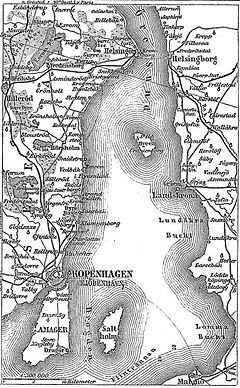- Sound Dues
-
The Sound Dues (Danish: Øresundstolden, Swedish: Öresundstullen) were a toll on the use of the Sound which constituted up to two thirds of Denmark's state income in the 16th and 17th centuries. The dues were introduced by King Eric of Pomerania in 1429 and remained in effect until the Copenhagen Convention of 1857.
All foreign ships passing through the strait, whether en route to or from Denmark or not, had to stop in Helsingør and pay a toll to the Danish Crown. If a ship refused to stop, cannons in both Helsingør and Helsingborg could open fire and sink it. In 1567, the toll was changed into a 1-2% tax of the cargo value, providing three times more revenue.
In order to avoid ships simply taking a different route, tolls were also collected at the two other Danish straits, the Great Belt and the Little Belt; sometimes non-Danish vessels were forbidden to use any other waterways but the Øresund, and transgressing vessels were confiscated or sunk.
The Sound Dues remained the most important source of income for the Danish Crown for several centuries, thus making Danish kings relatively independent of Denmark's Privy Council and aristocracy. However, the dues were an irritant to nations engaged in trade in the Baltic Sea, especially Sweden. Sweden had initially been exempted from the dues at the time of their introduction because it was then in the Kalmar Union along with Denmark. However, after the Kalmar War and the Treaty of Knäred in 1613 Denmark introduced dues on cargoes from Sweden's Baltic possessions and on non-Swedish ships carrying Swedish cargo. The friction over the Dues was an official casus belli of the Torstenson War in 1643.
In 1658/1660, Denmark had to cede her provinces east of the sound (Scania, Halland, Blekinge, Bohuslän, and the island of Ven) to Sweden as a consequence of the Second Northern War. Thus, the toll could not be enforced as well as before but Denmark retained its established right of the dues. Swedish shipping became exempt from the Sound Dues by the terms of the Treaty of Copenhagen, signed on 27 May 1660. The exemption was rescinded after Sweden's defeat in the Great Northern War and the Treaty of Frederiksborg of 1720, although the eastern shore of the Sound was now Swedish.
Copenhagen Convention
The Copenhagen Convention, which came info force on 14 March 1857,[1] abolished the dues and all Danish Straits were made international waterways free to all military and commercial shipping. It had been increasingly evident that the Sound Dues had a negative impact on the port and merchants of Copenhagen, although the dues delivered by then one eighth of the Danish state income; and the world's sea-using nations were becoming less and less tolerant of these tolls and restrictions. In compensation for the abolition, the Danish state received a one-time fee of 33.5 million Danish rigsdalers,[2] paid to Denmark by the other European shipping nations who signed the Convention. Of the total fee, Great Britain paid approximately one third, and Russia another third.[3] A similar convention between Denmark and the United States, signed in Washington the same year, gave American ships free passage in perpetuity for a one-time fee of $393,000.[3]
References
- ^ "Legal provision: maritime law". UNESCO. http://www.unesco.org/csi/act/russia/legalpro6.htm.
- ^ Hvidegaard, Torben (2 May 2005). "Øresundstolden". Dansk-Skånsk Tidsskrift. http://www.danskskaanskforening.dk/DST/2-05-oresundstolden.htm. (Danish)
- ^ a b Alexandersson, Gunnar (1982). International Straits of the World: The Baltic Straits. Martinus Nijhoff Publishers. ISBN 902472595X.
Coordinates: 55°47′23″N 12°45′03″E / 55.78972°N 12.75083°E
Categories:- History of Denmark
- Toll roads
- Straits of Denmark
- 1429 establishments
- 1857 disestablishments
- Law of the sea
Wikimedia Foundation. 2010.

